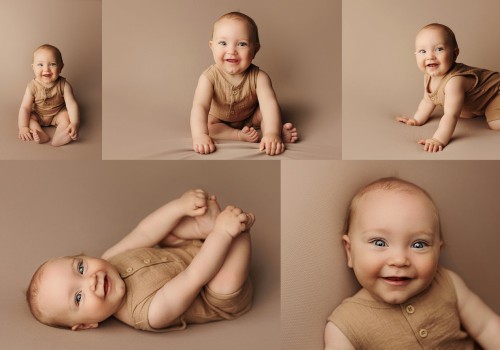As a parent, capturing the perfect moment of your infant’s life is something that you’ll want to remember for years to come. Whether it’s the first time they take a few steps, or when they give their first smile, you’ll want to make sure that each image is perfect. For this reason, editing techniques for infants are essential for any photographer that wants to capture the best shots. In this article, we will explore the best editing techniques for infants so that you can make sure each image is perfect and captures your baby’s magical moments. Infant photography is a unique challenge due to the fact that infants are so small and move around so quickly.
It is important to have the right editing techniques in your toolkit in order to make the most of your shots. In this article, we will discuss the best editing techniques for infant photography, including cropping, color correction, exposure adjustment, and other editing techniques.
Cropping
is the process of cutting out parts of the image that are not necessary or detract from the overall composition. When cropping an infant photo, it is important to maintain a natural look and not cut out any important features.Color Correction is the process of adjusting the hue, saturation, and luminance of an image to make it more visually appealing. It is important to maintain natural skin tones and colors when editing an infant photo.
Exposure Adjustment
is the process of adjusting the brightness and contrast of an image to bring out details or enhance the overall look. It is important to be careful when adjusting the exposure of an infant photo as too much adjustment can lead to unnatural looking images.Other Editing Techniques include sharpening, noise reduction, vignetting, and retouching. These techniques should be used sparingly as they can have a negative effect if used incorrectly. When editing infant photos, it is important to remember to maintain a natural look while still making adjustments to bring out the best in the image. With the right editing techniques, you can create beautiful images that capture your special moments with your infant.
Cropping
Cropping is an important editing technique used to improve the composition of infant photographs.It involves removing parts of the image that are not necessary or distracting from the overall photo. This could include removing a background object, adjusting the frame to focus on the subject, or changing the aspect ratio of the picture. Cropping can help to improve infant photos by making the subject more prominent in the frame and by creating a more pleasing composition. For example, you may want to crop a picture of an infant so that the focus is on their face, or to adjust the aspect ratio to make it look more balanced. Before and after images can help to illustrate the impact that cropping can have on infant photos.
Other Editing Techniques
Apart from the basic editing techniques, there are several other editing methods that can be used to enhance an infant photo.For instance, vignetting is a great way to draw attention to the subject of the photo and blur out the background. This creates a more dramatic effect and can make your infant photo stand out. Another technique is selective desaturation, which allows you to selectively choose certain colors in an image and desaturate them, while keeping the rest of the colors intact. This can be used to make certain elements pop in your photo.
Similarly, you can also use a selective blur tool to blur out certain elements in your photo while keeping the subject in focus. These techniques can be combined with other editing methods such as cropping, color correction, and exposure adjustment to create stunning images of infants. You can also use filters to give your photos a unique look and feel. For example, you can use a black and white filter to create a timeless look or a vintage filter to create a nostalgic feel.
To get an idea of how these techniques can be used to enhance an infant photo, take a look at the before and after images below. The first image shows a baby in its natural setting with minimal editing. The second image shows the same baby after using cropping, color correction, vignetting, selective desaturation, and selective blur.
Exposure Adjustment
Exposure adjustment is an important editing technique for capturing the best moments of infant photography. It involves adjusting the brightness and contrast of an image in order to bring out details or make the image look better overall.For example, if an infant photo has a lot of bright whites and shadows that are too dark, exposure adjustment can be used to brighten up the whites and darken the shadows to make the image more balanced. Before and after images can show the dramatic difference that exposure adjustment can make. For example, a photo of a baby in a brightly lit room can appear dull and washed out if the exposure is not adjusted correctly. But with a few simple adjustments, the same photo can take on a much more vibrant and dynamic look. It is also important to note that too much exposure adjustment can result in noise or artifacts in an image. To avoid this, it is best to only make small adjustments at a time until the desired effect is achieved.
Color Correction
Color correction is the process of adjusting the color of a photo to produce a desired effect.It is an essential editing technique for infant photography, as it can help create a more natural-looking image or enhance certain colors to draw attention to a specific subject or area. Color correction can be used to make subtle adjustments, such as increasing warmth or adding a cool tint, or more drastic changes, such as desaturating or replacing the dominant color in the image. Examples of color correction include adding contrast, increasing saturation, adjusting white balance, and adjusting hue and brightness. When editing infant photos, color correction can be used to enhance the natural beauty of a photo.
For example, a photo taken indoors may be lacking in natural light, so increasing contrast and saturation can help make the colors pop. Similarly, increasing warmth in a photo can add a cozy feeling or give the photo a more inviting atmosphere. By using before and after images, you can get a better idea of what color correction can do for an infant photo. For example, a photo taken indoors may appear too dark and drab before color correction, but brightening up the colors and increasing the saturation can create a beautiful image with vivid colors.
Similarly, a photo taken outdoors in direct sunlight may be too bright and washed out before color correction, but reducing the brightness and increasing the warmth can make it look much more natural. The best editing techniques for infant photography require a delicate touch. It is important to maintain natural skin tones and colors, adjust exposure carefully, and use other editing techniques sparingly. With practice, you can create beautiful photos that capture the innocence and beauty of infants. Cropping, color correction, exposure adjustment, and other editing techniques are essential for creating beautiful infant photos.
Taking the time to get to know these editing techniques can help you create stunning images that will be cherished for years to come.








Leave a Comment